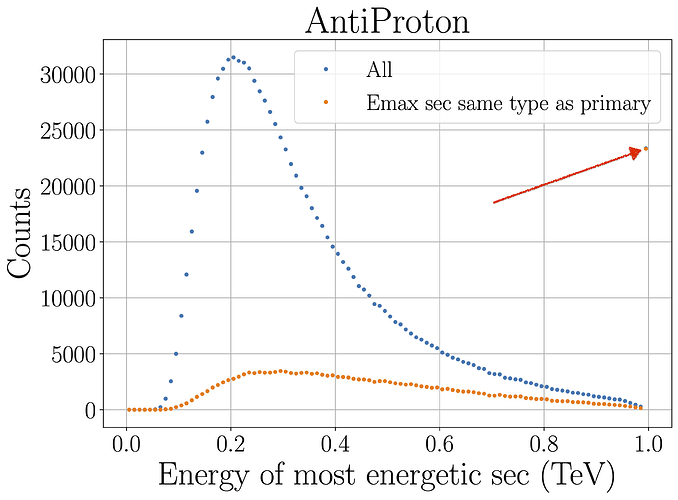Hi all,
While looking at the secondaries from inelastic hadronic interactions, I noticed that certain events seem to be displaying the characteristics of elastic rather than inelastic collisions.
To illustrate this point, I’ve created an example starting from /extended/hadronic/Hadr03. In this example, I have modified the code so that it also stores
- the energy of the most energetic secondary
- the energy of the most energetic secondary IF the most energetic secondary is of the same type as the primary
Running this setup with the macro inelastic.mac, I obtain the following distribution for the collision of 1 TeV antiproton on Bismuth-209 (simulated 1 million events)
Blue: Energy distribution of most energetic secondary
Orange: Same but only for events in which the most energetic secondary is also an anti-proton
What’s striking is that 2.3% of events fall in the last bin. I.e. these are events in which the most energetic secondary is also an anti-proton with almost the exact same energy as the primary. Repeating this setup for other primaries it gives:
- Proton: similar result, 4.0% in last bin
- Neutron: similar result, 3.9% in last bin
- Alpha: No issue, no events in last bin
- Carbon-12: No issue, no events in last bin
Context: I am currently working on an analysis to perform a measurement of the inelastic hadronic cross section of proton and helium. As simulation framework we consider Geant4 and FLUKA. Our measurement for helium is consistent between Geant4 and FLUKA. Our measurement for proton from Geant4 is inconsistent with FLUKA. However, if we apply an add-hoc correction to account for the fraction of elastic collisions that Geant4 considers as inelastic, the results are consistent.
Ideally, I would prefer to have a more solid solution than this add-hoc correction. My questions are:
- Has anyone come across this effect before?
- Do people agree that these are elastic events?
- If so, is there a way to set up the physics model in such a way that these events do not contribute to the inelastic processes?
Geant4 Version: 11.2.0
Operating System: CentOS7
Compiler/Version: gcc (GCC) 11.3.0
CMake Version: 3.26.2
Physics list: G4HadronPhysicsFTFP_BERT
Environment was set using:
source /cvmfs/sft.cern.ch/lcg/releases/gcc/11.2.0/x86_64-centos7/setup.sh
source /cvmfs/sft.cern.ch/lcg/views/LCG_105/x86_64-centos7-gcc11-opt/setup.sh
